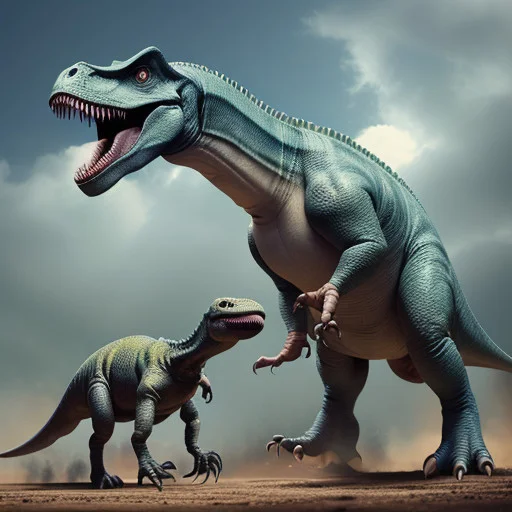The enigma surrounding the extinction of dinosaurs has captivated the human imagination for centuries. As we delve into the Mesozoic Era, we encounter the colossal reptiles that once dominated our planet. What brought about their sudden demise? Join us on a journey through the annals of Earth's history as we explore various theories, from asteroid impacts to volcanic eruptions and changing climates.
Introduction
Dinosaurs, the iconic creatures that ruled the Earth for millions of years, mysteriously vanished, leaving behind a puzzle that scientists have been trying to solve. The Mesozoic Era, commonly known as the Age of Dinosaurs, witnessed the evolution and flourishing of various dinosaur species, each adapted to its unique environment.
The Age of Dinosaurs
During the Mesozoic Era, dinosaurs reigned supreme. From the towering Tyrannosaurus rex to the gentle giant Brachiosaurus, these creatures shaped the ecosystems they inhabited. Understanding this era is crucial to unraveling the events that led to the disappearance of these majestic beings.
Theories on Dinosaur Extinction
Several theories attempt to explain the demise of dinosaurs, with the impact theory, volcanic activity hypothesis, and climate change perspectives being the most prominent. Each theory provides a different perspective on the catastrophic event that altered the course of Earth's history.
Impact Theory: A Closer Look
The discovery of the Chicxulub crater in the Yucatán Peninsula bolstered the impact theory, suggesting a massive asteroid collided with Earth. The aftermath of this collision caused widespread devastation, triggering a chain reaction that led to the extinction of dinosaurs.
Volcanic Activity Hypothesis
An alternative hypothesis links dinosaur extinction to intense volcanic activity, particularly the eruption of the Deccan Traps. Examining the role of volcanic gases in climate change, scientists explore the connections between these eruptions and the decline of dinosaur populations.
Climate Change Perspectives
Changing environmental conditions during the late Cretaceous period played a crucial role in shaping the destiny of dinosaurs. Fluctuating sea levels, alterations in atmospheric composition, and other climatic factors may have pushed these creatures to the brink of extinction.
The Dinosaur-Bird Connection
Intriguingly, some dinosaurs managed to survive the catastrophic event, eventually evolving into modern birds. Exploring this evolutionary link provides insights into the resilience of life on Earth and the adaptability of these prehistoric creatures.
The Great Dying: Mass Extinctions in Earth's History
Comparing the dinosaur extinction event with other mass extinctions in Earth's history offers valuable perspectives. Understanding the patterns and consequences of these events contributes to our knowledge of the fragility and resilience of life on our planet.
Paleontological Discoveries
Fossils serve as windows into the past, allowing paleontologists to reconstruct the world in which dinosaurs lived. Ongoing scientific exploration continues to unearth new discoveries, enriching our understanding of these ancient beings.
Human Impact on Dinosaurs
While the age of dinosaurs ended millions of years ago, human activities today impact the ecosystems that host their fossils. Conservation efforts, responsible paleontological practices, and awareness of our role in preserving Earth's history are essential.
Controversies and Debates
The scientific community engages in ongoing discussions and debates, refining theories and challenging preconceptions. Differing opinions contribute to the dynamic nature of paleontological research, driving scientists to uncover the truth behind the demise of dinosaurs.
Popular Culture and Dinosaurs
Dinosaurs continue to captivate the human imagination through various forms of media. Movies, books, and art shape public perception, perpetuating the fascination with these ancient creatures and influencing how we envision their existence.
Unanswered Questions
Despite decades of research, mysteries persist. Unanswered questions leave room for continued exploration and scientific inquiry, driving researchers to push the boundaries of knowledge and uncover new revelations about dinosaur life and extinction.
Conclusion
In summary, the disappearance of dinosaurs remains one of the greatest mysteries in Earth's history. Theories abound, each offering valuable insights into the complex web of events that led to their extinction. The enduring allure of dinosaurs lies not only in their colossal stature but in the enigma surrounding their final chapter.
FAQs
Why did some dinosaurs survive the extinction event?
Some smaller dinosaur species likely adapted to the changing conditions and evolved into modern birds, ensuring their survival.
How do scientists determine the age of dinosaur fossils?
Radiometric dating techniques, such as carbon dating and uranium-lead dating, help scientists estimate the age of dinosaur fossils.
Were all dinosaurs gigantic, or were there smaller species?
Dinosaurs varied in size, with some species being small and agile, while others were massive and formidable.
What role did plant life play in the dinosaur ecosystem?
Plant life was crucial, providing food for herbivorous dinosaurs and sustaining the entire ecosystem.
Are there any chances of dinosaurs making a comeback?
The possibility of dinosaurs making a comeback is purely speculative and remains firmly in the realm of science fiction.


.jpg)




